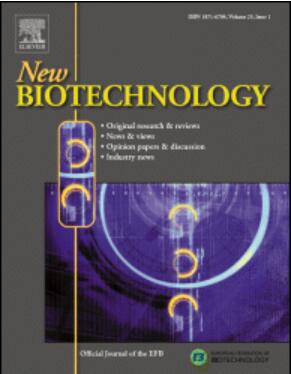Enhancing 2,3-butanediol and acetoin production from brewer's spent grain hemicellulosic hydrolysate through bacterial co-cultivation
IF 4.5
2区 生物学
Q1 BIOCHEMICAL RESEARCH METHODS
引用次数: 0
Abstract
This study evaluated bacterial co-cultivation as a strategy to mitigate brewer’s spent grain (BSG) hemicellulosic hydrolysate toxicity, aiming to enhance 2,3-butanediol (2,3-BDO) and acetoin production through fermentation. Co-culture of Paenibacillus polymyxa with Pseudomonas alloputida or Rhodococcus sp. was assessed using synthetic medium and BSG hydrolysate. Attention was given to removing inhibitory compounds, including lignin-derived phenolics, hydroxymethylfurfural, furfural, and acetic acid, through microbial detoxification during co-cultivation. Various fermentation temperatures (30, 34, and 37 °C) and initial cell concentrations (OD600 of 0.05 and 0.1) were tested. Both P. polymyxa and Rhodococcus sp. effectively removed inhibitory compounds present in the medium. Co-cultures with Rhodococcus sp. exhibited higher sugar consumption rates (1.01 vs 0.88 g/L·h) than P. polymyxa monoculture, efficiently utilizing glucose, xylose, and arabinose, producing 2,3-BDO and acetoin. In co-culture with Rhodococcus sp., concentration (3.7 g/L), yield (0.14 g/g) and productivity (0.10 g/L·h) of 2,3-BDO at 34 °C considerably surpassed that of the P. polymyxa monoculture, with an increase of up to 48 %. These findings highlight the potential of co-cultures, especially with Rhodococcus sp., to alleviate inhibitory compound impacts when using complex media for fermentation. This study represents the first exploration of 2,3-BDO and acetoin production from BSG hemicellulosic hydrolysates using co-cultures.
求助全文
约1分钟内获得全文
求助全文
来源期刊

New biotechnology
生物-生化研究方法
CiteScore
11.40
自引率
1.90%
发文量
77
审稿时长
1 months
期刊介绍:
New Biotechnology is the official journal of the European Federation of Biotechnology (EFB) and is published bimonthly. It covers both the science of biotechnology and its surrounding political, business and financial milieu. The journal publishes peer-reviewed basic research papers, authoritative reviews, feature articles and opinions in all areas of biotechnology. It reflects the full diversity of current biotechnology science, particularly those advances in research and practice that open opportunities for exploitation of knowledge, commercially or otherwise, together with news, discussion and comment on broader issues of general interest and concern. The outlook is fully international.
The scope of the journal includes the research, industrial and commercial aspects of biotechnology, in areas such as: Healthcare and Pharmaceuticals; Food and Agriculture; Biofuels; Genetic Engineering and Molecular Biology; Genomics and Synthetic Biology; Nanotechnology; Environment and Biodiversity; Biocatalysis; Bioremediation; Process engineering.
 求助内容:
求助内容: 应助结果提醒方式:
应助结果提醒方式:


